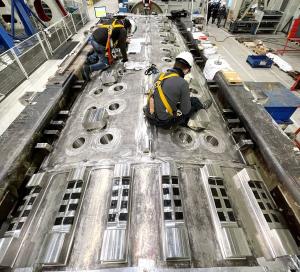Fitting the pieces virtually
With only millimetres to spare and huge components to be adjusted by crane, the operation is a challenging one. For vacuum vessel sector #5—the first in the European series—Fusion for Energy has introduced a virtual tool that takes metrology data from the completed segments and fits them together virtually, in advance of the actual operation.
The tool is capable of generating a simulation based on more than 1 million surveyed points, and highlighting various interface zones. By simulating different alignment scenarios, the contractors are able to arrive at the best and most optimized fit solution.
"It helps project managers to minimize risks and have a precise control of the assembly," explains Fusion for Energy metrology expert Alessandro Lo Bue, who worked with colleague Edoardo Pompa (SETIS Groupe Degaud) to build the methodology for virtual fitting from specialized software (SpatialAnalyzer®).
The tool has been in use for vacuum vessel sector #5 since November 2020.
See a report on the Fusion for Energy website here.


